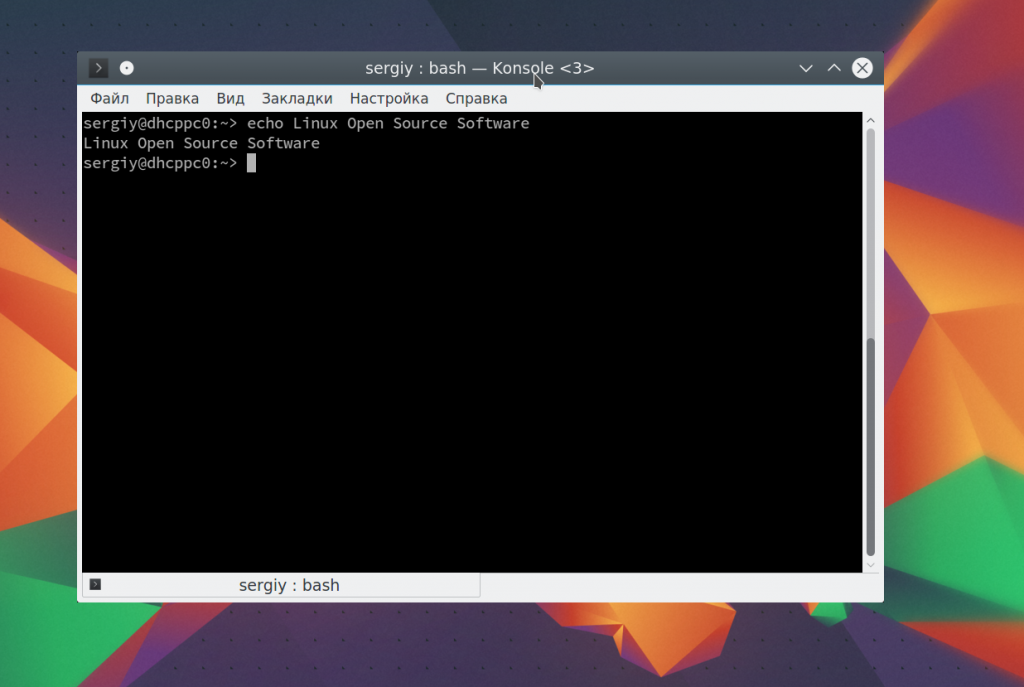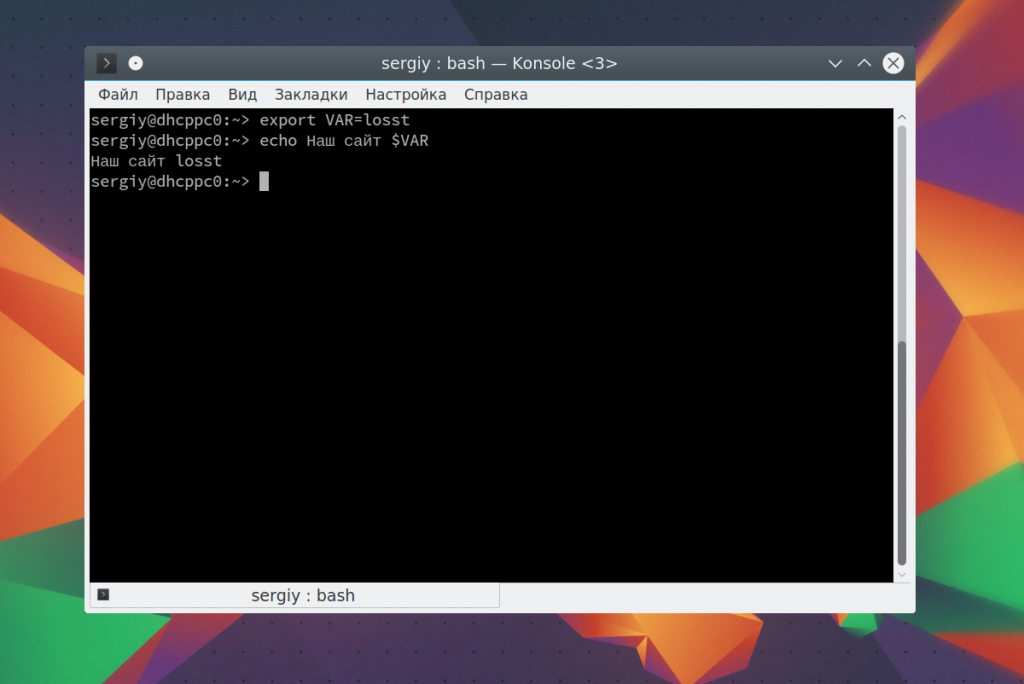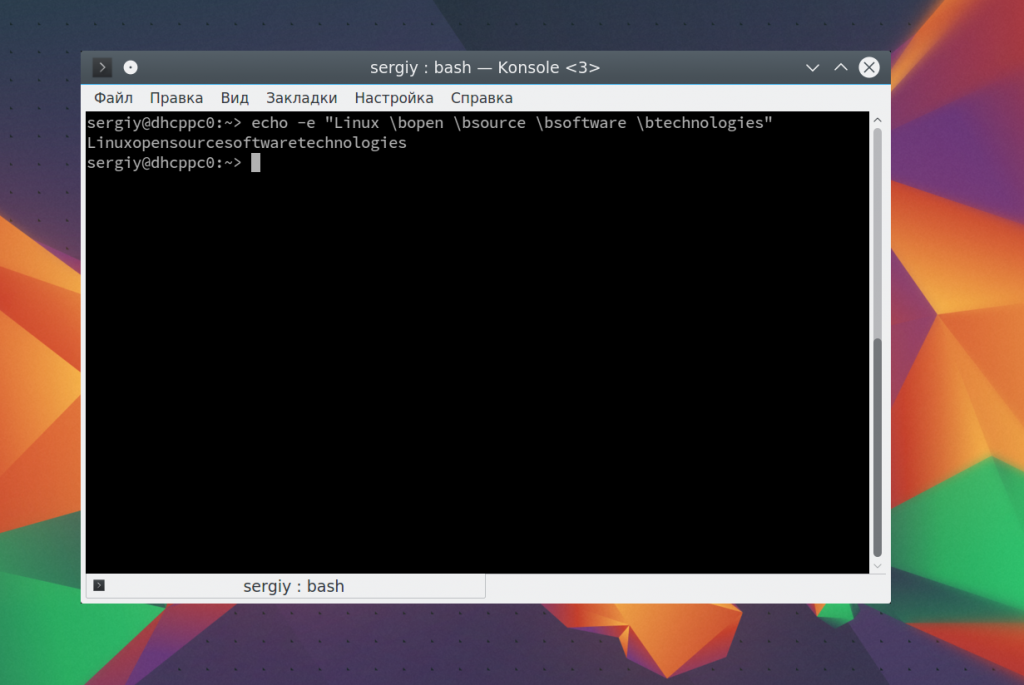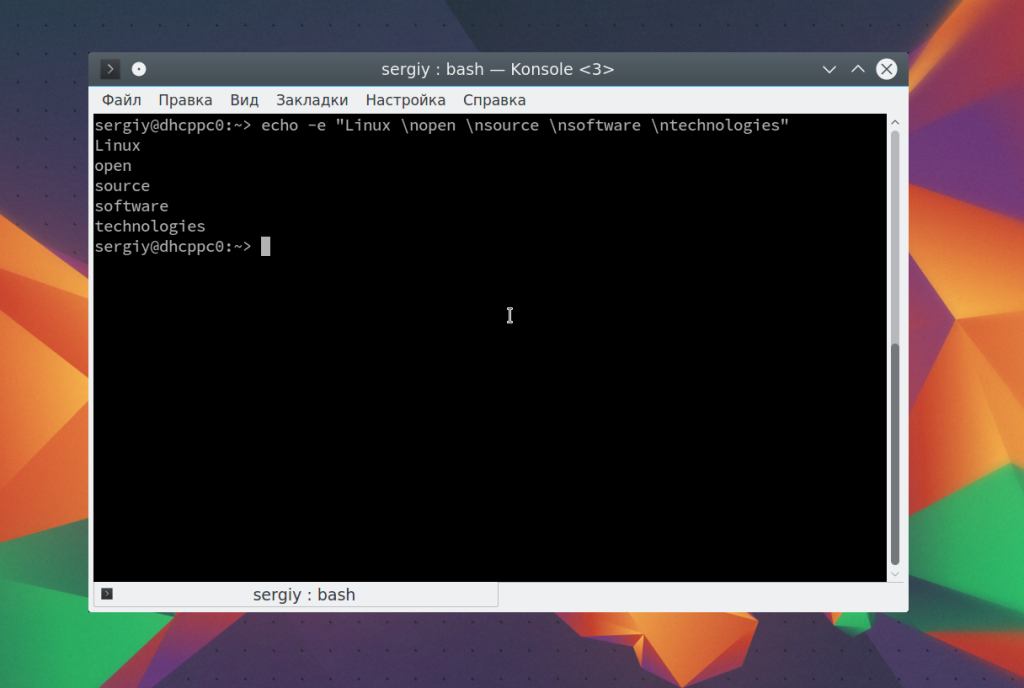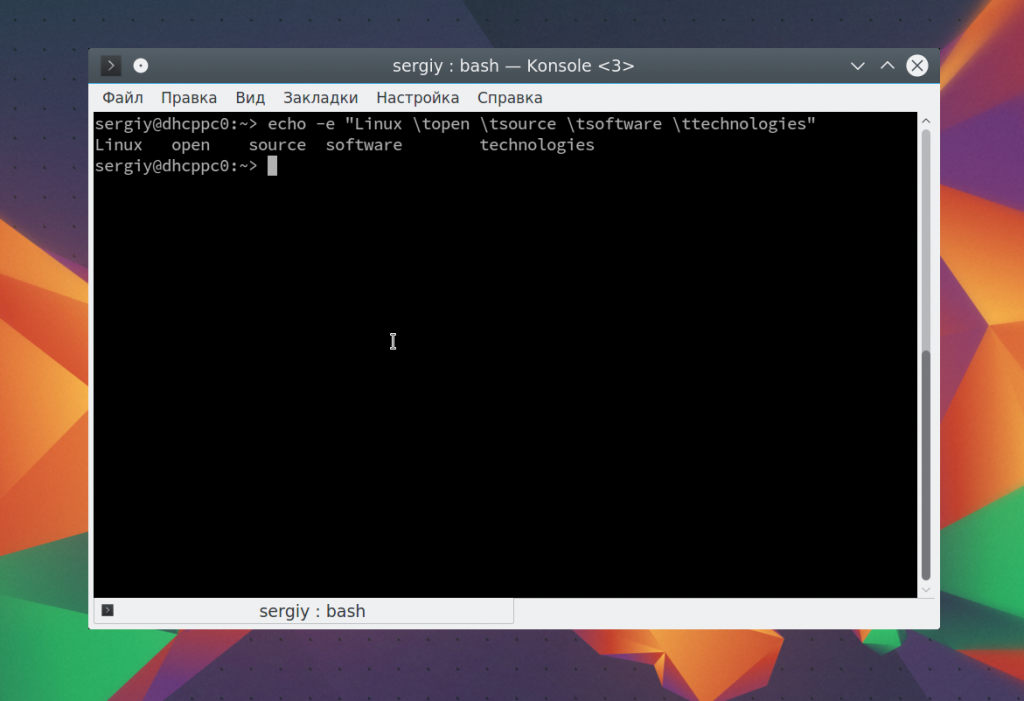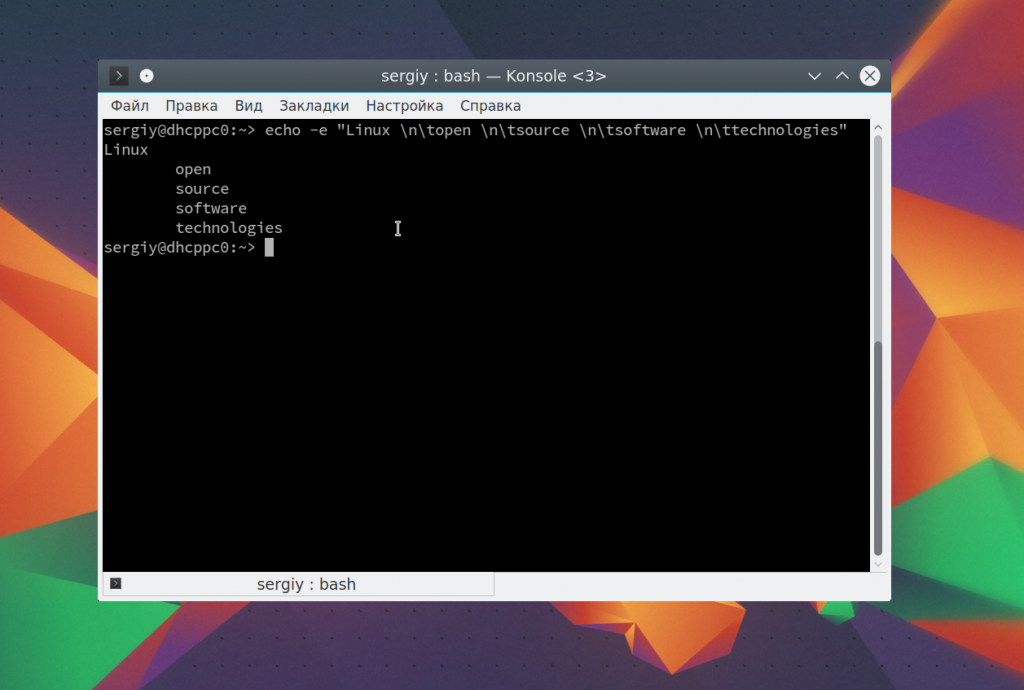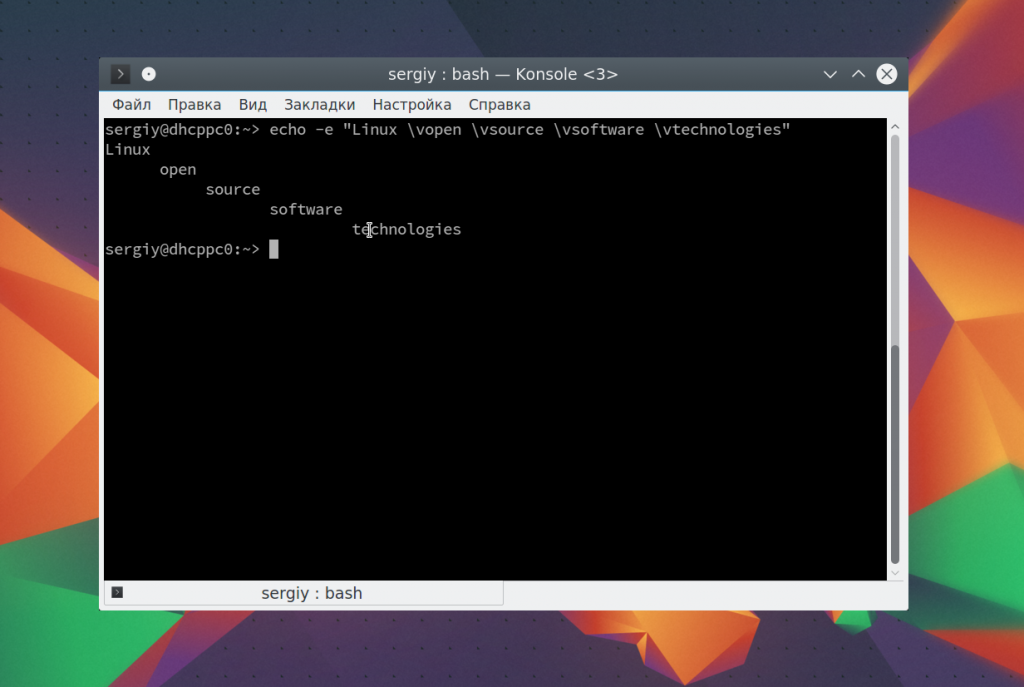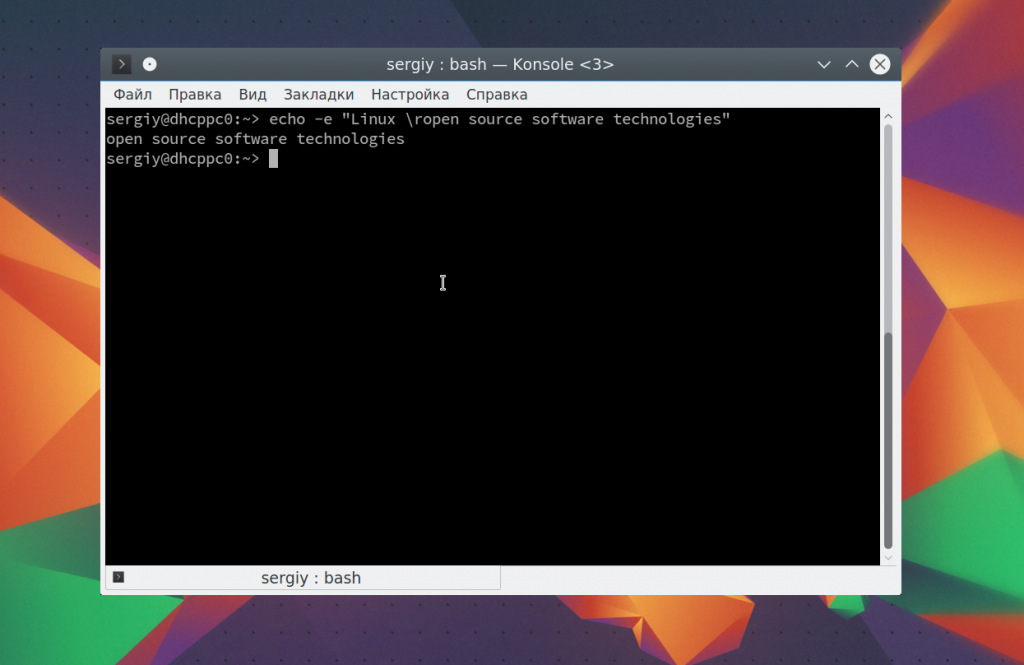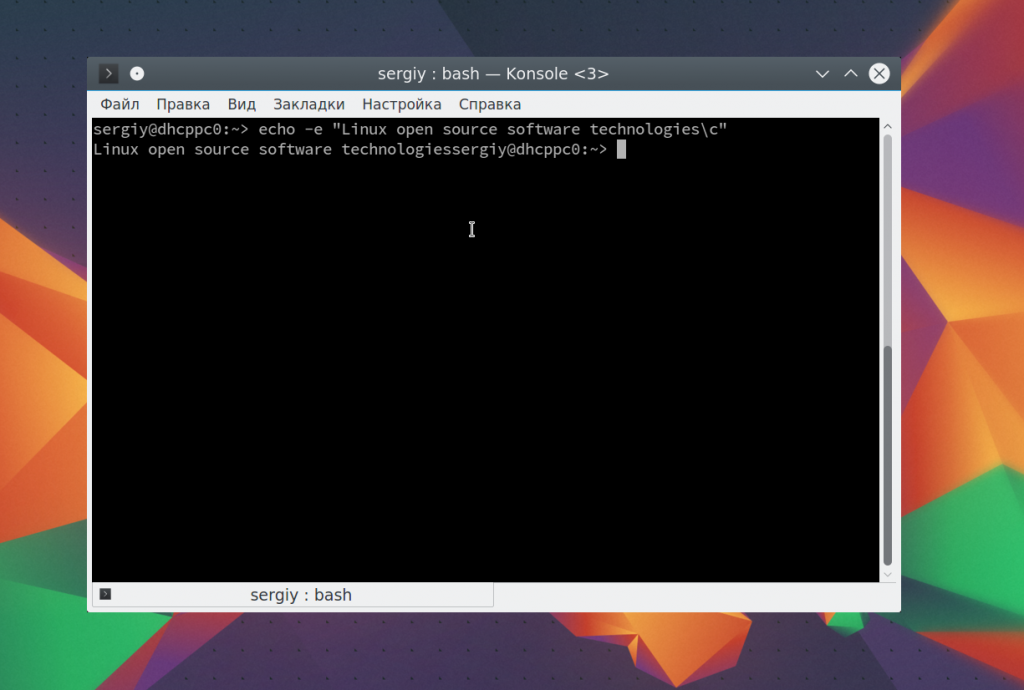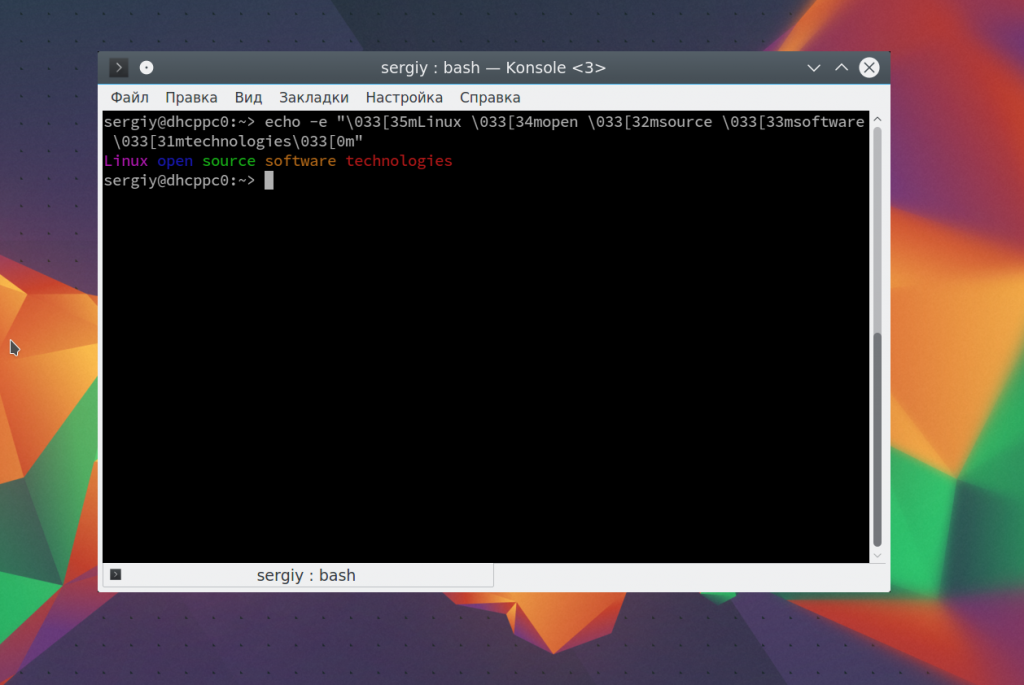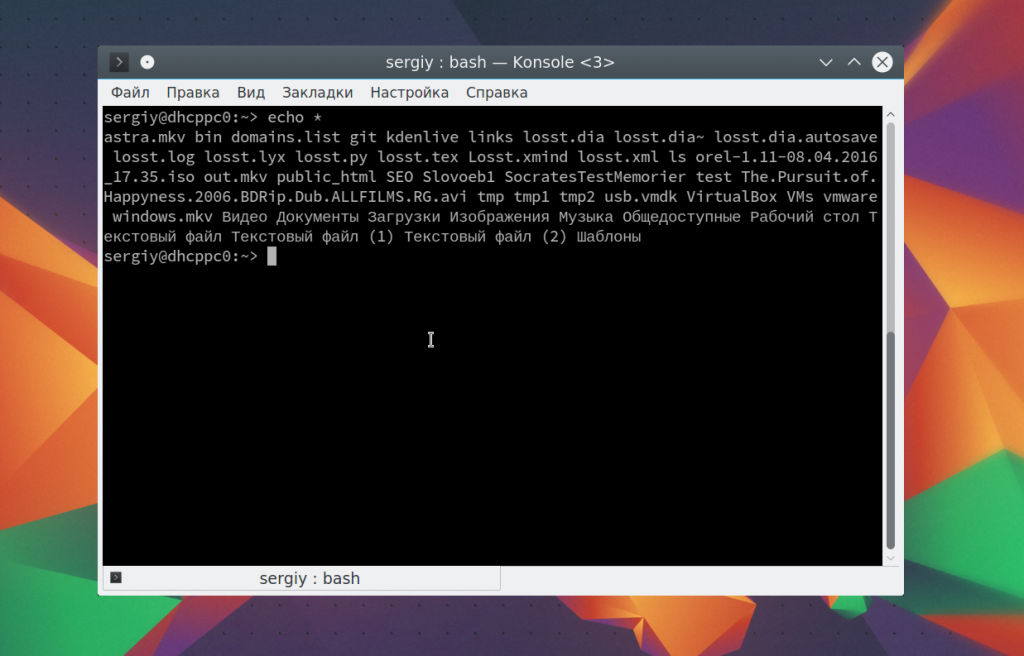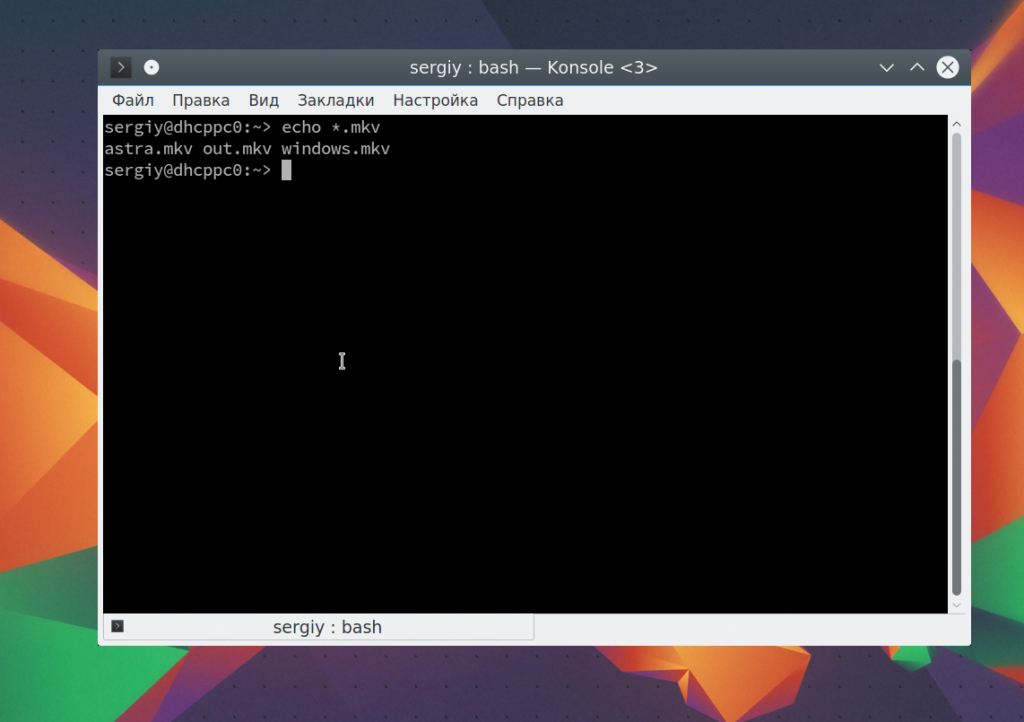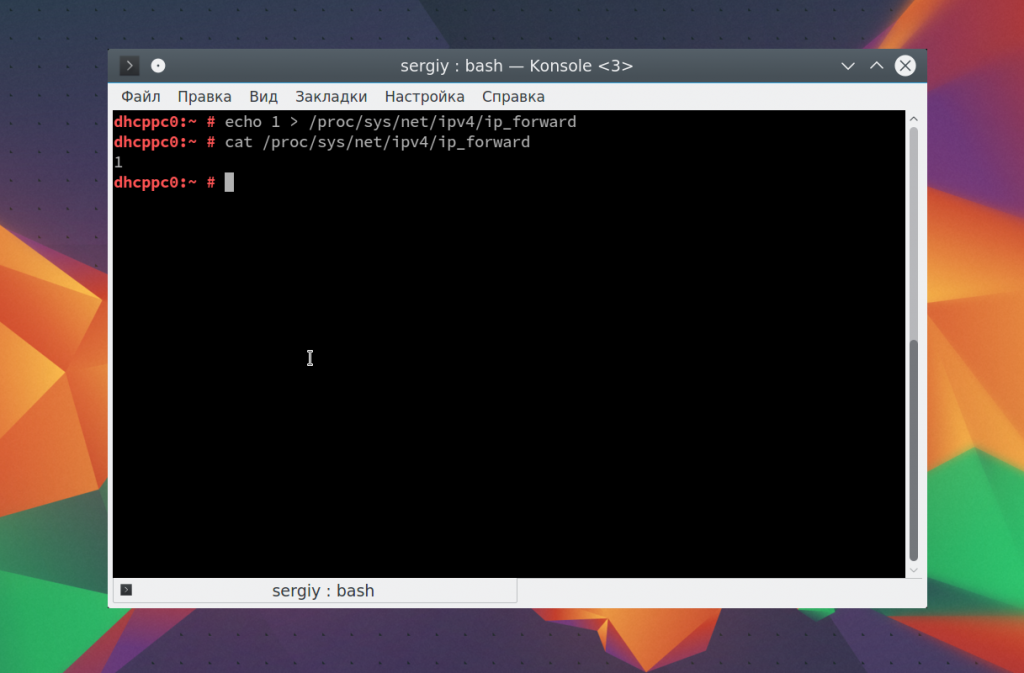- Команда echo в Linux
- Команда echo linux
- Примеры работы echo
- Выводы
- 15 Practical Examples of ‘echo’ command in Linux
- 16 echo command examples in Linux
- 1) Display a simple message on the terminal
- 2) Print out the value of a variable with echo command
- 3) Print a line of text comprising of double quotes
- 4) Display a line of text consisting of a single quote
- 5) Redirect echo command output to a file
- 6) Use echo command to match identical files
- 7) List all files and folders in the current directory
- 8) Create new lines using the echo command
- 9) Create tab spaces between words in a sentence
- 10) Combine new line and tab spacing options in echo command
- 11) Create vertical tab spaces in echo command output
- 12) Combine new line and vertical tab spaces in echo command
- 13) Use the carriage return option
- 14) Truncate echo command output of text
- 15) Remove all spaces from the text string with echo command
- 16) echo command usage in bash shell script
Команда echo в Linux
Команда echo — это очень простая и в то же время часто используемая встроенная команда оболочки Bash. Она имеет только одно назначение — выводить строку текста в терминал, но применяется очень часто в различных скриптах, программах, и даже для редактирования конфигурационных файлов.
В этой статье мы рассмотрим что представляет из себя команда echo linux, как ее можно использовать и в каких ситуациях. Но сначала рассмотрим синтаксис самой команды.
Команда echo linux
Команда echo — это не системная утилита, у нее нет исполняемого файла. Она существует только внутри интерпретатора Bash. Синтаксис команды echo linux очень прост:
$ echo опции строка
Опций всего несколько, давайте рассмотрим их, чтобы вы могли лучше ориентироваться в работе утилиты:
- -n — не выводить перевод строки;
- -e — включить поддержку вывода Escape последовательностей;
- -E — отключить интерпретацию Escape последовательностей.
Это все опции, если включена опция -e, то вы можете использовать такие Escape последовательности для вставки специальных символов:
- /c — удалить перевод строки;
- /t — горизонтальная табуляция;
- /v — вертикальная табуляция;
- /b — удалить предыдущий символ;
- /n — перевод строки;
- /r — символ возврата каретки в начало строки.
Пожалуй, это все, что нужно знать о команде echo, а теперь давайте рассмотрим как с ней работать.
Примеры работы echo
Давайте рассмотрим как пользоваться echo. Сначала просто выведем строку на экран:
echo Linux Open Source Software Technologies
Также можно вывести значение переменной. Сначала объявим переменную:
Затем выведем ее значение:
Как уже говорилось, с помощью опции -e можно включить интерпретацию специальных последовательностей. Последовательность \b позволяет удалить предыдущий символ. Например, удалим все пробелы из строки:
echo -e «Linux \bopen \bsource \bsoftware \btechnologies»
Последовательность \n переводит курсор на новую строку:
echo -e «Linux \nopen \nsource \nsoftware \ntechnologies»
С помощью \t вы можете добавить горизонтальные табуляции:
echo -e «Linux \topen \tsource \tsoftware \ttechnologies»
Можно совместить переводы строки и табуляции:
echo -e «Linux \tnopen \tnsource \tnsoftware \tntechnologies»
Точно так же можно применить вертикальную табуляцию:
echo -e «Linux \vopen \vsource \vsoftware \vtechnologies»
С помощью последовательности \r можно удалить все символы до начала строки:
echo -e «Linux \ropen source software technologies»
Последовательность -c позволяет убрать перевод на новую строку в конце сообщения:
echo -e «Linux open source software technologies\c»
Дальше — больше. Вы можете разукрасить вывод echo с помощью последовательностей управления цветом Bash. Для доступны такие цвета текста:
Например. раскрасим нашу надпись в разные цвета:
echo -e «\033[35mLinux \033[34mopen \033[32msource \033[33msoftware \033[31mtechnologies\033[0m»
С основными параметрами команды echo разобрались, теперь рассмотрим еще некоторые специальные символы bash. Вы можете вывести содержимое текущей папки просто подставив символ *:
Также можно вывести файлы определенного расширения:
Я уже говорил, что echo можно использовать для редактирования конфигурационных файлов. Вы можете использовать запись echo в файл linux, если он пуст:
echo 1 > /proc/sys/net/ipv4/ip_forward
Если файл не пуст, и вам необходимо добавить свою строчку в конец файла используйте символ перенаправления вывода >>:
echo «UUID=09ec0871-2f55-4dd5-aeb2-cacc4a67907c /var/tmp btrfs subvol=@/var/tmp 0 0» >> /etc/fstab
Если строка содержит какие-либо специальные символы или может быть понята интерпретатором неоднозначно, следует заключить ее в кавычки.
Выводы
В этой статье была рассмотрена команда echo linux. Несмотря на свою простоту, она может применяться для решения различных задач и незаменима при написании простых скриптов. Надеюсь, эта информация была вам полезной.
Обнаружили ошибку в тексте? Сообщите мне об этом. Выделите текст с ошибкой и нажмите Ctrl+Enter.
15 Practical Examples of ‘echo’ command in Linux
The echo command is one of the most commonly and widely used built-in commands for Linux bash and C shells, that typically used in a scripting language and batch files to display a line of text/string on standard output or a file.
The syntax for the echo command is:
1. Input a line of text and display it on standard output
$ echo Tecmint is a community of Linux Nerds
Outputs the following text:
Tecmint is a community of Linux Nerds
2. Declare a variable and echo its value. For example, Declare a variable of x and assign its value=10.
$ echo The value of variable x = $x The value of variable x = 10
Note: The ‘-e‘ option in Linux acts as an interpretation of escaped characters that are backslashed.
3. Using option ‘\b‘ – backspace with backslash interpretor ‘-e‘ which removes all the spaces in between.
$ echo -e "Tecmint \bis \ba \bcommunity \bof \bLinux \bNerds" TecmintisacommunityofLinuxNerds
4. Using option ‘\n‘ – New line with backspace interpretor ‘-e‘ treats new line from where it is used.
$ echo -e "Tecmint \nis \na \ncommunity \nof \nLinux \nNerds" Tecmint is a community of Linux Nerds
5. Using option ‘\t‘ – horizontal tab with backspace interpretor ‘-e‘ to have horizontal tab spaces.
$ echo -e "Tecmint \tis \ta \tcommunity \tof \tLinux \tNerds" Tecmint is a community of Linux Nerds
6. How about using option new Line ‘\n‘ and horizontal tab ‘\t‘ simultaneously.
$ echo -e "\n\tTecmint \n\tis \n\ta \n\tcommunity \n\tof \n\tLinux \n\tNerds" Tecmint is a community of Linux Nerds
7. Using option ‘\v‘ – vertical tab with backspace interpretor ‘-e‘ to have vertical tab spaces.
$ echo -e "\vTecmint \vis \va \vcommunity \vof \vLinux \vNerds" Tecmint is a community of Linux Nerds
8. How about using option new Line ‘\n‘ and vertical tab ‘\v‘ simultaneously.
$ echo -e "\n\vTecmint \n\vis \n\va \n\vcommunity \n\vof \n\vLinux \n\vNerds" Tecmint is a community of Linux Nerds
Note: We can double the vertical tab, horizontal tab, and new line spacing using the option two times or as many times as required.
9. Using option ‘\r‘ – carriage return with backspace interpretor ‘-e‘ to have specified carriage return in output.
$ echo -e "Tecmint \ris a community of Linux Nerds" is a community of Linux Nerds
10. Using option ‘\c‘ – suppress trailing new line with backspace interpretor ‘-e‘ to continue without emitting new line.
11. Omit echoing trailing new line using the option ‘-n‘.
12. Using option ‘\a‘ – alert return with backspace interpretor ‘-e‘ to have the sound alert.
$ echo -e "Tecmint is a community of \aLinux Nerds" Tecmint is a community of Linux Nerds
Note: Make sure to check the Volume key, before firing.
13. Print all the files/folders using echo command (ls command alternative).
$ echo * 103.odt 103.pdf 104.odt 104.pdf 105.odt 105.pdf 106.odt 106.pdf 107.odt 107.pdf 108a.odt 108.odt 108.pdf 109.odt 109.pdf 110b.odt 110.odt 110.pdf 111.odt 111.pdf 112.odt 112.pdf 113.odt linux-headers-3.16.0-customkernel_1_amd64.deb linux-image-3.16.0-customkernel_1_amd64.deb network.jpeg
14. Print files of a specific kind. For example, let’s assume you want to print all ‘.jpeg‘ files, use the following command.
15. The echo can be used with a redirect operator to output to a file and not standard output.
echo Options
| Options | Description |
| -n | do not print the trailing newline. |
| -e | enable interpretation of backslash escapes. |
| \b | backspace |
| \\ | backslash |
| \n | new line |
| \r | carriage return |
| \t | horizontal tab |
| \v | vertical tab |
That’s all for now and don’t forget to provide us with your valuable feedback in the comments below.
16 echo command examples in Linux
In this guide, we will explain Linux echo command with 16 practical examples.
Echo command in Linux is one of the widely used command in day-to-day operations task. The echo command is a built-in command-line tool that prints the text or string to the standard output or redirect output to a file. The command is usually used in a bash shell or other shells to print the output from a command. Echo command is also used frequently in bash shell scripts.
Syntax of echo command

1) Display a simple message on the terminal
To print a simple text message on the terminal with echo command , run the command:
2) Print out the value of a variable with echo command
Let’s assume that you have initialized a variable x and assigned it a value of 100 as shown
You can echo its value by prefixing the variable name with a dollar sign as shown
3) Print a line of text comprising of double quotes
To print a line of text with double quotes with echo command, simply enclose the phrase in double-quotes between single quotes.
$ echo Hello guys welcome to ' "Linuxtechi" '
4) Display a line of text consisting of a single quote
If you wish to print a line with a word containing a single quote, enclose the word inside double quotation marks as shown:
$ echo Hey, "We're" Linuxtechi, a community driven site.
5) Redirect echo command output to a file
To redirect echo command output to a file instead of printing it on the screen use the greater than( > ) and double greater than ( >> ) operators.
When you use the greater than( > ) operator, the file will be overwritten. If the file does not exist, it will be created.
$ echo Hey guys, Welcome to Linuxtechi > greetings.txt
The double greater than operator ( >> ) appends text to a file. For example, to add an entry to the /etc/hosts files use the syntax shown
$ echo 192.168.2.100 web-server-01 >> /etc/hosts
6) Use echo command to match identical files
You can use echo command with a wildcard character to return identical files i.e files that bear the same file extension. For example, to print out all text files with the .txt extension , run the command.
7) List all files and folders in the current directory
The echo command can act as the ls command and list all the files and folders in your current directory using the wildcard as shown:
8) Create new lines using the echo command
Using the backslash interpreter -e , you can manipulate how the line appears on the output. For example, to print a new line, use the ‘ \n ‘ escape character option as shown below:
$ echo -e "Welcome \nto \nLinuxtechi \ncommunity"
9) Create tab spaces between words in a sentence
Apart from creating a new line, you can increase the spacing between words in a sentence using the ‘\t ‘ or TAB option as shown.
$ echo -e "Welcome \tto \tLinuxtechi \tcommunity"
10) Combine new line and tab spacing options in echo command
You can combine the ‘\n’ and ‘\t’ options at the same time as shown:
$ echo -e "\n\tWelcome \n\tto \n\tLinuxtechi \n\tcommunity"
11) Create vertical tab spaces in echo command output
The \v option enables you to create vertical tab spaces as shown:
$ echo -e "Welcome \vto \vLinuxtechi \vtcommunity"
12) Combine new line and vertical tab spaces in echo command
Additionally, you can experiment and combine the ‘\n’ and ‘\v ‘ options as shown.
$ echo -e "Welcome \n\vto \n\vLinuxtechi \n\vtcommunity"
13) Use the carriage return option
The \r option omits the preceding text. For example, the output of the command below omits the first 2 words.
$ echo -e "Welcome to \rLinuxtechi community"
14) Truncate echo command output of text
To suppress any further output and proceed without going to the next line use the ‘\c’ option as shown:
$ echo -e Welcome to Linuxtechi \ccommunity
15) Remove all spaces from the text string with echo command
Use ‘ \b’ option along with -e option in echo command to remove all the spaces from the text string, example is shown below:
$ echo -e "Welcome \bto \bLinux \bCommunity" WelcometoLinuxCommunity $
16) echo command usage in bash shell script
As we have already stated that echo command is frequently used in bash shell scripts. Example of echo command usage in shell script are listed below:
$ cat echo-bash.sh #!/bin/bash # Echo Command Usage in Script os_version=$(grep -i "PRETTY_NAME" /etc/os-release | awk -F'=' '' | sed 's/"//g') no_cpus=$(lscpu | grep '^CPU(s):' | awk -F":" '' | sed "s/^[ \t]*//") total_mem=$(grep MemTotal /proc/meminfo | awk -F":" '' | sed "s/^[ \t]*//") echo 'OS Version :' $os_version echo 'Number of CPUs :' $no_cpus echo 'Total Memory :' $total_mem $
Output of above script when it is executed:
$ bash echo-bash.sh OS Version : CentOS Linux 7 (Core) Number of CPUs : 4 Total Memory : 8008968 kB $
And that’s it. Thank you for taking your time in this guide. Hopefully, you are now better informed.
